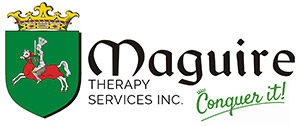Has a friend or family member ever told you they have a “slipped disc”? You’ve probably heard the term a few times, however, it’s actually a misnomer, since discs don’t actually ever “slip” but either degenerate, bulge, or herniate.
Painful? Maybe. Annoying? Absolutely. Fortunately, a physical therapist can treat all these issues!
The latter condition, called a disc herniation, occurs when the outer layer of the disc tears. This allows the disc’s inner gel-like substance to leak out into the surrounding joint area. This ruptured disc tissue can then press on nearby structures, like nerve roots and joint spaces.
A disk herniation, or herniated disk, can occur in any part of the spine, causing numbness, pain or weakness throughout the body. They can be caused by repeated or excessive strain and there has been evidence that suggests herniated disks can be genetic, although the likelihood of a herniated disk has been shown to greatly increase with age.
Could this be what’s causing your pain?
The Most Common Signs and Symptoms of a Herniated Disc
Not all herniated discs affect patients in the same way. Some may cause very little to no pain at all, often going unnoticed. And even if they do cause pain they won’t all present themselves in the same way. But there are some common signs and symptoms we see among our patients who come to us with this type of spinal condition. They include:
- Back pain and stiffness. This usually occurs right around the level of the herniated disc. There may also be overlying muscle spasms as a protective response.
- Weakness in an arm or leg. Again, this is caused by compression of a nerve root near the injured disc. Many people notice foot drop (an inability to flex their ankle up), weakened grip strength, or frequent tripping or “clumsiness.”
- Pain, numbness, and tingling that radiates into an arm or leg. This happens if the herniated disc compresses a nearby spinal nerve root.
- Pain that gets worse with certain movements. In many cases, forward flexion (bending forward in the spine) can cause a herniated disc to bulge even more out of place, which can increase pain or cause it to peripheralize (move farther down a limb). Meanwhile, backward extension (leaning backward in the spine) can cause the herniated disc to retract back into better alignment, which can decrease pain or cause it to centralize (move up a limb and closer to the spine).
Risk Factors You Should Know for Herniated Discs
Studies have shown that a herniated disc can happen to anyone and can be common depending on your level of daily activity, diet, age group, etc. but you may be more at risk based on your age, gender, body mass index (BMI), smoking, herniation type, diabetes, and herniation level. More specific risk factors include:
- Amount sf sitting done in a day
- Frequency of bending, heavy lifting, or twisting
- Having a physically demanding job
- If you’ve suffered a traumatic event, such as a fall or auto accident
- Being obese or overweight
- Being a male
- If you’re between the ages of 30 and 50
- Having a family history of disc and spine problems
Here’s what a Physical Therapist Can Do for Your Herniated Disc
Though you may be looking for the newest, quickest, and most revolutionary treatment for your herniated disk, it’s considered best practice to seek conservative treatment options like physical therapy long before undergoing any surgical intervention.
In fact, scientific evidence shows us that individualized physical therapy in addition to education and lifestyle advice is highly effective for reducing chronic back pain, including back pain caused by a herniated disc. And because physical therapy is a largely non-invasive process tailored to the patient, it doesn’t expose them to potential risks and adverse reactions of surgery, including opioid addiction, failed back surgery syndrome (FBSS), and post-operative pain, bleeding, and infection.
If you believe you have a herniated disc, we strongly encourage you to seek help from a physical therapist. It will do more than put you in the right state of mind and ease you into a place where you can identify the best treatment for yourself. He or she can perform various tests and assess your history to make or confirm a diagnosis, so you’ll have a better understanding of what you’re dealing with. Then, he or she can prescribe customized interventions to alleviate your symptoms, heal the injured disc, and perhaps most importantly prevent recurring problems! Expect services such as:
- Core stabilization exercises
- Stretches to improve mobility elsewhere in the body, especially the shoulders and hips
- Non-invasive modalities like electrical stimulation, cold laser therapy, and diathermy
- Manual therapy, including massage and traction
Physical Therapy is the most pain-free, safe, and efficient way of treating your herniated disk. Let us help you solve that mystery today!


